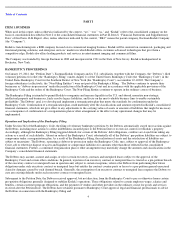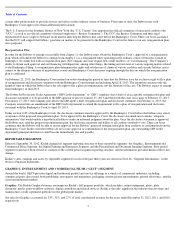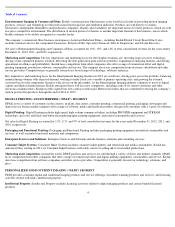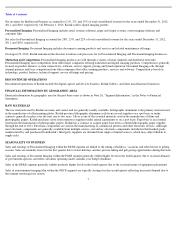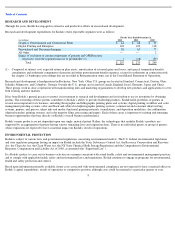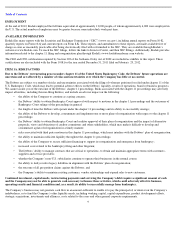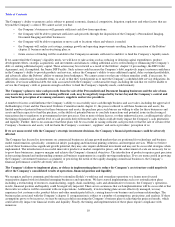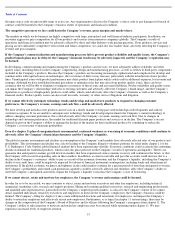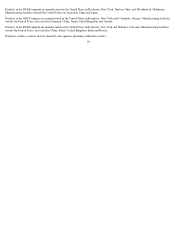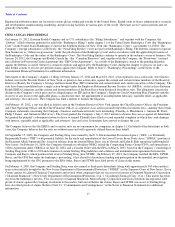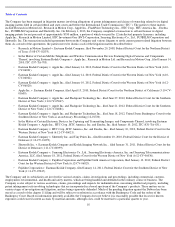Kodak 2012 Annual Report Download - page 15
Download and view the complete annual report
Please find page 15 of the 2012 Kodak annual report below. You can navigate through the pages in the report by either clicking on the pages listed below, or by using the keyword search tool below to find specific information within the annual report.
Table of Contents
the open source code on unfavorable terms or at no cost. Any requirement to disclose the Company’s source code or pay damages for breach of
contract could be harmful to the Company’s business results of operations and financial condition.
The competitive pressures we face could harm the Company’s revenue, gross margins and market share.
The markets in which we do business are highly competitive with large, entrenched, and well financed industry participants. In addition, we
encounter aggressive price competition for all our products and services from numerous companies globally. The Company’s results of
operations and financial condition may be adversely affected by these and other Industry-wide pricing pressures. If our products, services and
pricing are not sufficiently competitive with current and future competitors, we could also lose market share, adversely affecting the Company’s
revenue and gross margins.
If the Company’s commercialization and manufacturing processes fail to prevent product reliability and quality issues, the Company’s
product launch plans may be delayed, the Company’s financial results may be adversely impacted, and the Company’s reputation may
be harmed.
In developing, commercializing and manufacturing the Company’s products and services, we must adequately address reliability and other
quality issues, including defects in the Company’s engineering, design and manufacturing processes, as well as defects in third-
party components
included in the Company’s products. Because the Company’s products are becoming increasingly sophisticated and complicated to develop and
commercialize with rapid advances in technologies, the occurrence of defects may increase, particularly with the introduction of new product
lines. Unanticipated issues with product performance may delay product launch plans which could result in additional expenses, lost revenue and
earnings. Although we have established internal procedures to minimize risks that may arise from product quality issues, there can be no
assurance that we will be able to eliminate or mitigate occurrences of these issues and associated liabilities. Product reliability and quality issues
can impair the Company’s relationships with new or existing customers and adversely affect the Company’s brand image, and the Company’s
reputation as a producer of high quality products could suffer, which could adversely affect the Company’s business as well as the Company’s
financial results. Product quality issues can also result in recalls, warranty, or other service obligations and litigation.
If we cannot effectively anticipate technology trends and develop and market new products to respond to changing customer
preferences, the Company’s revenue, earnings and cash flow, could be adversely affected.
We must develop and introduce new products and services in a timely manner to keep pace with technological developments and achieve
customer acceptance. If we are unable to anticipate new technology trends and develop improvements the Company’s current technology to
address changing customer preferences, this could adversely affect the Company’s revenue, earnings and cash flow. Due to changes in
technology and customer preferences, the market for traditional film and paper products and services is in decline. The Company’s success
depends in part on the Company’s ability to manage the decline of the market for these traditional products by continuing to reduce the
Company’s cost structure to maintain profitability.
Even if a chapter 11 plan of reorganization is consummated, continued weakness or worsening of economic conditions could continue to
adversely affect the Company’s financial performance and the Company’s liquidity.
The global economic environment and declines in consumption in the Company’s end markets have adversely affected sales of our products and
profitability. This environment and decline was a factor leading to the Company filing for voluntary petitions for relief under chapter 11 of the
U.S. Bankruptcy Code. Further, global financial markets have been experiencing volatility. Economic conditions could accelerate the continuing
decline in demand for traditional products, which could also place pressure on the Company’s results of operations and liquidity. There is no
guarantee that anticipated economic growth levels in markets that have experienced some economic recovery will continue in the future, or that
the Company will succeed in expanding sales in these markets. In addition, accounts receivable and past due accounts could increase due to a
decline in the Company’s customers’ ability to pay as a result of the economic downturn, and the Company’s liquidity, including the Company’
s
ability to use credit lines, could be negatively impacted by failures of financial instrument counterparties, including banks and other financial
institutions. If the global economic weakness and tightness in the credit markets continue for a greater period of time than anticipated or worsen,
the Company’s profitability and related cash generation capability could be adversely affected and, therefore, affect the Company’s ability to
meet the Company’s anticipated cash needs, impair the Company’s liquidity or increase the Company’s costs of borrowing.
If we cannot attract, retain and motivate key employees, the Company’s revenue and earnings could be harmed.
In order for us to be successful, we must continue to attract, retain and motivate executives and other key employees, including technical,
managerial, marketing, sales, research and support positions. Hiring and retaining qualified executives, research and engineering professionals,
and qualified sales representatives, particularly in the Company’s targeted growth markets, is critical to the Company’s future. If we cannot
attract qualified individuals, retain key executives and employees or motivate the Company’s employees, the Company’s business could be
harmed. The Company’s filing for chapter 11 may create additional distractions and uncertainty for employees, and impact the Company’s
ability to retain key employees and effectively recruit new employees. Furthermore, as is typical in chapter 11 restructurings, there may be
changes in the composition of the Company’s Board of Directors and its officers following the Company’s emergence from chapter 11. The
Company’s ability to take measures to motivate and retain key employees may be restricted while operating under chapter 11. We may
experience increased levels of employee attrition.
13


